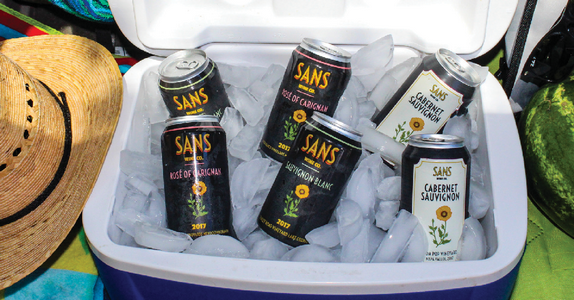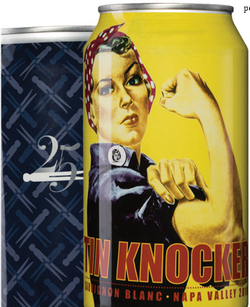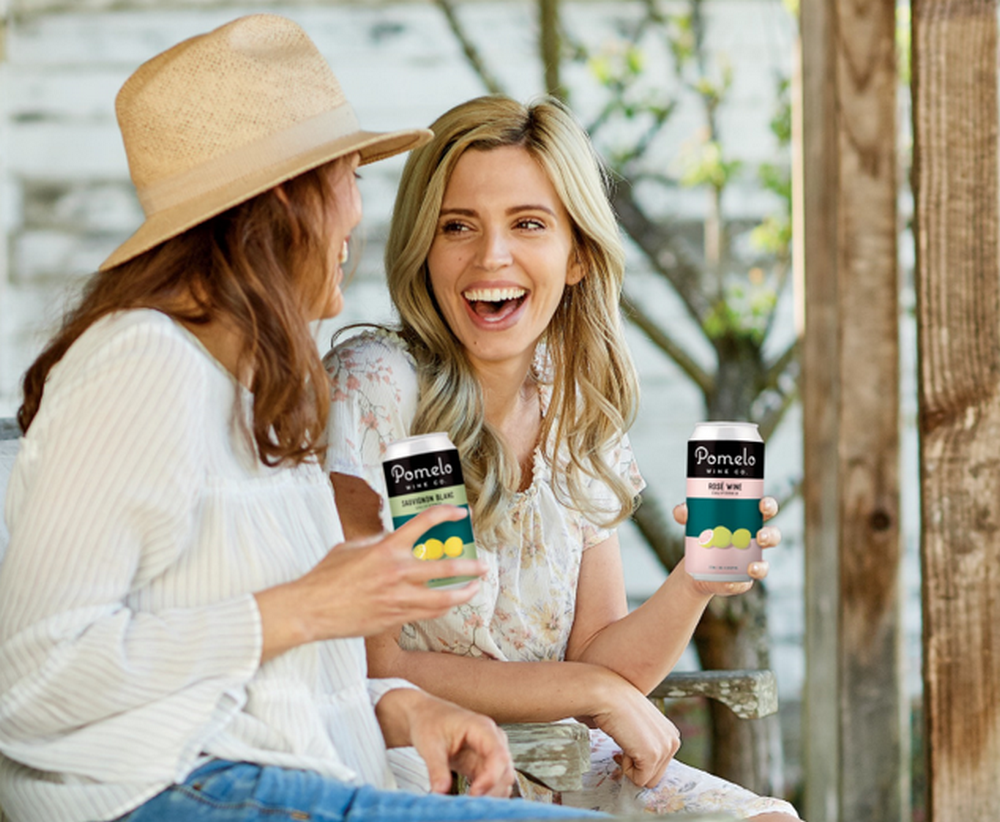In a shift from novel to normal, canned wine hits its stride
When the Oakland Athletics played the Milwaukee Brewers in a home game this August, a completely different kind of brewer and diamond were the attention grabbers. The Family Coppola was serving their Diamond Collection of 250ml canned wines: Pinot Noir, Chardonnay, Sauvignon Blanc, and Pinot Grigio, plus the canned wine trail- blazer introduced in 2004, sparkling Sofia Blanc de Blancs.
Thanks to a new three-year partnership between the A’s and the winery, fans at Oakland Coliseum are finding out how well canned wine pairs with wings, sliders, and hot dogs. In addition to the sports stadium, canned wines are being popped open at both predictable and surprising places, offered by boutique label producers as well as the big names.
CANNED SUCCESS
Another big California winery, Trinchero Family Estates, announced the release of its Pomelo label non-vintage Sauvignon Blanc and Rosé in 375ml cans priced at $6. With its summer launch, Trinchero joined other major wine marketers, including E. & J. Gallo, Foley Family, Treasury Wine Estates, and The Wine Group in contributing to the wildly rapid growth for the canned wine business.
The evidence points to an escalating trend rather than a fad. For the 52-week period ending June 15, 2019, canned wine retail sales grew 69% to reach nearly $70 million, according to Nielsen. That’s up astronomi- cally from just $2 million in 2012
As canned wines undergo a consumer- driven shift from novelty to normal to your grocery shelves, it’s not only the larger wineries contributing to the trend of wine in cans. In Napa, local winemakers such as Larkin Wines, Three Clicks Wines, and Sans Wines are among those enthusiastically em- bracing the segment, perhaps a surprising space for quality, small production vintners.

IDEATION AND ADOPTION
And why not? Canned wines are an idea whose time has come. Bruce Devlin, owner/ winemaker at Three Clicks Wines says that most people welcome it. “When we started our brand as an all screwball brand back
in 2006, I would say the resistance to it at the time was greater than what we’re now seeing with cans.”
Where will the segment be in five years? Devlin predicts there will be two kinds of canned wine and nowhere in-between: “Those of us who put quality wine in a can and those who base it on price.” Over the course of 10 years, he doesn’t see much in new changes, because “the format is rapidly being adopted.”
ADVENTURE CALLS FOR CANS
Besides enjoying wine in a can at ballgame bleacher seats, plenty of indoor and outdoor activities readily come to mind when a canned wine would be just the trick: A camping trip, hiking, skiing, kayaking, in a hot tub, on a houseboat, at a rooftop pool bar, a music festival, on a picnic blanket in the park, at the theater, the cinema or at a Broadway show. It’s just right for door- to-door dinner deliveries on the back of a scooter, too.
Is this a use list that speaks to having appeal across generations? Absolutely.
“The target customer is me,” said Devlin. “I grew up camping and enjoying the outdoors with my family.” The way Devlin sees it, “The format has so many applications, and we’re just at the tip of the iceberg. Just wait for all the sports events, airplanes, amusement parks, and that little golf cart that drives around the course with drinks to figure it out.”
TO KNOW THEM IS TO LOVE THEM
Conundrum: Everybody knows that glass is not a good idea at the beach. Nevertheless, wine is a good idea at the beach. Sitting on the sand and chatting with friends, Yountville winemaker Sean Larkin (who calls himself a “devout and unapologetic hedonist raconteur”) got to thinking…and you can see where this is going. A hand-sized vessel for fine wine, why not? An “ultra-premium Napa Valley heavy hitter” in a can with a label that says LARKAN is where he took it.
 The beach resort community loves it. Sean Larkin says LARKAN is a big hit in “my second home, Nantucket,” where it’s served at Dreamland Film & Cultural Center; The Gaslight, a live entertainment venue; and The Nautilus Restaurant, listed on the menu under “wines from people & places we love.”
The beach resort community loves it. Sean Larkin says LARKAN is a big hit in “my second home, Nantucket,” where it’s served at Dreamland Film & Cultural Center; The Gaslight, a live entertainment venue; and The Nautilus Restaurant, listed on the menu under “wines from people & places we love.”
“The Domaine Carneros rosé is a big hit, as is the Pritchard Hill white in a can,” Larkin said. “People try them in restaurants or pick them up at Mollie Stone’s and Gary’s Wine and Marketplace. I was so pleased with the request for LARKAN to commemorate the 25th anniversary of French Laundry, and that introduced new fans, too.”
Larkin and other quality canned wine producers freely admit that for some consumers, it may take time to get adjusted to the concept. These are not bulk wines from maximum yield producing Central Valley vineyards. “At $12, it’s a deal,” said Larkin. “Remember, at 375ml, a can is a half-bottle of wine. People come over to my house and ask for a can, not realizing they’re actually going to get a buzz on if they chug it like a soft drink or a beer. This is quality Napa wine.”
THE PRICE IS RIGHT
At Sans Wine Company, husband-and-wife team Jake Stover and Gina Schober have been putting top quality, organically farmed wines into aluminum since 2015. It’s the first—and only—single vineyard Napa Valley Cabernet Sauvignon in a can; it never sees oak. “When you think about it, a can is a great vessel for good wine, like a small version of a stainless steel tank,” Schober points out. “Plus, the cans are lightweight and recyclable.” Typically, each can is lined with a thin plastic flavor-proof barrier because wine and a funky metallic taste don’t mix.
There’s a trio of 375ml Sans cans: Carbonic rosé of Carignan, Sauvignon Blanc and Zinfandel, each with a suggested retail price between $10 and $12, and $25 for the 2017 Cabernet Sauvignon sourced from Napa’s Three Jacks Vineyard.
TRAVELING LIGHT
World travelers take note: Jack Edwards, a Napa-based direct wine importer, shares his wife’s genius idea for premium canned wine when traveling abroad. She places the cans of wine in checked luggage without having to worry about special packaging to guard against breakage. Upon arrival, simply relax and forget about room service, overpriced minibars, and rummaging around for a corkscrew.
Article By: Laurie Jo Miller Farr

